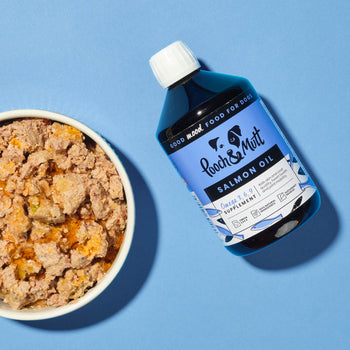Cushing’s disease is a fairly widespread illness that mostly affects senior dogs, with some studies suggesting around 1-2% of dogs over 8 years old may develop the condition (1). Though younger dogs can get it, too.
This article explores more about Cushing’s disease including the different types of the illness, what symptoms to watch out for, as well as diagnosis, treatment, and ways to support your pooch.
What is Cushing's disease in dogs?
Cushing's disease in dogs refers to a condition where a tumour that sits on your dog's pituitary gland causes them to produce too much of the Adrenocorticotropic Hormone (ACTH). This hormone is the one responsible for telling their adrenal glands to produce cortisol (the stress hormone).
Whilst Cortisol is referred to as ‘the stress hormone’, it’s not as negative as it seems. Stress is actually vital for the body’s functioning, in humans as well as dogs.
Cortisol regulates not only stress, but also metabolism and immune function - so when the body releases too much cortisol it can cause all kinds of issues. Being able to balance cortisol levels when they go off-kilter is integral for overall health and wellbeing.

What is the difference between Cushing's disease and Cushing’s syndrome?
Cushing’s disease is actually a form of Cushing’s Syndrome.
Where Cushing’s disease refers to the overproduction og ACTH, Cushing’s Syndrome is the overarching term which refers to the presence of excess production of cortisol. This can be from either Cushing’s disease or the types caused by adrenal gland tumours or prolonged steroid use.
The terms are used interchangeably in the same way we refer to Alzheimer’s disease for the specific, dementia-related illness, but ‘dementia’ is the broader term for conditions involving memory loss.
What types of Cushing's syndrome are there in dogs?
There are three different types of cortisol-related illnesses under the Cushing’s syndrome umbrella, all with their own causes.
-
Pituitary-dependent Cushing’s. This is the type called Cushing’s disease - it’s the most common type, and is caused by a tumour on the pituitary gland. This pituitary-based tumour overstimulates the adrenal glands, where cortisol is produced.
-
Adrenal-dependent Cushing’s. This type is caused by a tumour on one of the adrenal glands, which causes cortisol to be overproduced.
-
Iatrogenic Cushing’s. This type stems from long-term steroid use. In this case, the steroids have caused too much cortisol in the body, and the dog shows the same symptoms as if it had come naturally from the adrenal glands.

What causes Cushing's disease?
Look out for the following indicators that your pooch might have Cushing’s disease/syndrome.
-
Increased thirst, peeing more often. These symptoms together are often the earliest signs of Cushing’s. This is because high cortisol affects the kidneys and disrupts fluid balance in the body. Take note if your dog’s water bowl gets empty quickly, they want to go outside to pee more often or if they have accidents in the house.
-
Your dog seems hungrier. High cortisol boosts appetite, meaning your pooch might eat quicker, beg for food more than usual and be sniffing around for scraps or treats.
-
Panting or heavy breathing, even when they’re at rest. Your dog will generally seem out of breath often and not totally relaxed.
-
Pot-bellied appearance. High cortisol leads to fat redistribution around the stomach, weakened abdominal muscles and an enlarged liver so your pooch may get a ‘pooch’ - that will seem pronounced even if there is no weight gain elsewhere.
-
Thinning skin and bald patches. Your dog’s coat may become dull and hair may fall out in patches; or their skin may become darkened, flaky or bruise easily. Wounds may take longer to heal. This is because cortisol reduces skin resilience and suppresses hair growth.
-
Your dog seems tired and lethargic. Lower energy levels will mean your dog may sleep more and not be their usual sprightly self.
-
They get recurring infections. Infected and itchy skin or urinary tract infections (UTIs) may become more common in a dog who has Cushing’s disease/syndrome.
Is my dog showing signs of ageing, or is it Cushing’s disease?
Cortisol levels do slowly creep up as a dog gets older, meaning a lot of the symptoms of Cushing’s syndrome do resemble the signs of ageing.
However, the symptoms of Cushing’s are more severe and will come on more quickly in a noticeable shift, while signs of ageing (peeing more often, gaining weight, reduced energy) will happen gradually over the years.

Treatment for Cushing’s disease in dogs
Treatment for Cushing’s conditions depends on the type, and is more about managing your dog’s symptoms than curing it.
Here is how Cushing’s syndrome is likely to be diagnosed and then treated by your vet.
How Cushing's disease in dogs is diagnosed
Diagnosis of Cushing’s disease or other cortisol-related conditions needs to be thorough and have several stages, as the symptoms can so easily be mistaken for other health conditions.
- First, a vet will physically examine your pooch, then take blood and urine tests to check for signs of high cortisol.
- Sometimes they’ll try hormone stimulation or suppression tests (such as an ACTH stimulation test or low-dose dexamethasone suppression test) - which basically means they will test how your dog’s body responds when triggered to produce cortisol.
- Your dog might have an ultrasound or MRI scan to detect any pituitary or adrenal tumours.
- Overall, your vet will be looking out for patterns of elevated cortisol alongside the characteristic symptoms of Cushing’s syndrome.
Are some breeds more prone to Cushing's disease?
Yes, some breeds are more susceptible, particularly to Cushing’s disease as it’s the most common type of Cushing’s syndrome.
Dog breeds that are prone to Cushing’s disease include:
It’s also more common in all older dogs, regardless of breed, and dogs who have been medicated with long-term steroids are more prone to Iatrogenic Cushing’s, regardless of breed.
Can Cushing’s disease in dogs be prevented?
Pituitary and adrenal tumours develop spontaneously with no real cause, so there isn’t really anything that can be done to prevention Cushing’s disease.
Only latrogenic Cushing’s syndrome has a known cause of prolonged steroid use, so be sure to closely follow veterinary guidance if your pooch needs steroids for a particular health issue.
Managing Cushing’s disease in dogs
Looking after a dog with Cushing’s disease or Cushing’s syndrome is about improving their quality of life; managing symptoms and keeping cortisol levels as controlled as possible.
Plus, how you treat it depends on the type of Cushing’s your dog has.
-
Pituitary-dependent Cushing’s is usually treated with medications that reduce cortisol production, and help with excessive drinking, panting and the pot-bellied appearance. Your pooch will need to have regular vet check-ups for the rest of their life to be sure the treatment is working well.
-
Adrenal-dependent Cushing’s. As this is often caused by a tumour on an adrenal gland, your dog may have the gland surgically removed. If caught early enough, this can even cure the symptoms. If surgery isn’t possible, however, your dog may be put on medications similar to those used for pituitary Cushing’s.
-
Iatrogenic Cushing’s is treated by gradually reducing or stopping steroid medication and managing symptoms. It’s very important to do this under vet supervision, as abruptly stopping steroids can be dangerous.
A dog with Cushing’s will also need extra care to manage any infections, skin complaints or other issues caused by high cortisol.
Give your pooch lots of love and affection, keep them active, and feed them nutritious, balanced dog food that supports their skin and coat, gut microbiome and immune system, so they can feel strong and well from the inside out.
Can Cushing’s disease in dogs be cured?
There isn’t a full cure for Cushing’s disease; treatment is about managing your dog’s symptoms and giving medication to balance their high cortisol levels.
With the right treatment and care, your dog can still live a good life - many dogs live for several years after discovering they have it (depending on their age at the time of diagnosis).
There is one caveat that could be considered a ‘cure’; in adrenal-dependent Cushing’s, sometimes an adrenal gland with a tumour is removed early enough that symptoms stop completely.
How long do dogs live with Cushing's disease?
If caught early and your dog responds well to medication and support, they can live for around 3-4 years after diagnosis.
If they aren’t treated, however, Cushing’s syndrome can prove fatal in less than a year - so getting the right medication is truly life-saving for a dog.
Bear in mind that if the dog is already quite old when they’re diagnosed, that can also have an impact.
Can Cushing's disease be treated naturally?
Though a well-balanced diet and natural supplements can be an excellent support for your dog with Cushing’s disease or syndrome, the condition shouldn’t be treated with natural remedies alone.
If your dog has a diagnosis from a vet, they can recommend a treatment plan that will help balance their cortisol levels and manage their symptoms, ultimately lengthening their life expectancy.
There is no full cure for Cushing’s conditions, so keeping your pooch comfortable, well-fed and active, and booked in with regular vet check-ups is the best thing for them.
What food is best for dogs with Cushing’s disease?
Keeping your pooch in general good health is the best route to supporting them through Cushing’s, so a well-balanced diet packed with nutritious whole ingredients is key (especially as an increased appetite is one of the symptoms!).
Our grain-free Skin & Coat Dry Food For Dogs contains ingredients to benefit a dog with Cushing’s - such as soothing omega-rich Herring, Biotin for strong hair, skin and nails, prebiotics and probiotics for a harmonious gut and immune system, and Collagen for skin resilience.
Drizzling our Salmon Oil For Dogs over their food, or trying out our Gut-Skin Support Supplement could also help boost your dog’s immune system, skin health and overall wellbeing and mood.
But remember, the best way to get the utmost out of your dog's supplements is to assess their health on the inside with a Gut Health Test.
If your dog has Cushing’s syndrome, try our range of nutritious grain-free dog food for skin and coat - full of delicious recipes, dog treats and gut-friendly supplements to support a pooch’s coat and skin. Always consult a vet before trying new foods for your dog’s health condition.
References
“Cushing’s syndrome—an epidemiological study based on a canine population of 21,281 dogs”, 2019 - Open Veterinary Journal.


















Comments (0)
Leave a comment